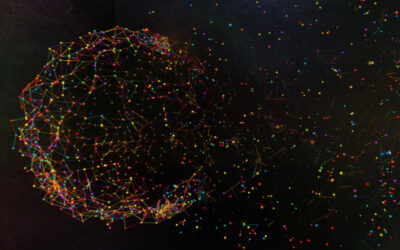Introduction to Part 2
This is the second part of our blog series “From Script to Data”, which shows how to use the Ontology for Media Creation to improve communication and automation in the production process. Part 1 went from the script to a set of narrative elements, and here we will use OMC to make the transition from narrative elements to production elements. Part 3 will take those production elements through filming and some aspects of post-production.
Production Elements
Dem bones Dem bones Dem dry bones
Dem bones Dem bones Dem dry boness
Dem bones Dem bones Dem dry bones,
Hear the word of the Lord
We now have a good abstract understanding of the script and its contents. What we don’t have is any idea of what the onscreen presentation looks like, who’s going to play the characters, and so on.
In this section, we bring in two new concepts.
Asset: A physical or digital object or collection of objects specific to the creation of a Creative Work.
Participant: The entities (people, organizations, and services) that are responsible for the production of the Creative Work.
Assets and Participants can be very complex in their details, but they both contains two broad types of information:
- Functional Characteristics say what an asset is used for or what a participant does: is an Asset a prop or a costume, for example, and is a participant a director or sound engineer.
- Structural Characteristics say what an asset or participant is: is the asset a physical thing or a CG model or a piece of video and is the participant a person or an organization or a software service.
You can find more about how this works and why we made this choice in Part 3: Assets and Part 4: Participants.
The ontology uses Assets and Participants to create production elements – the stuff that is needed to turn the narrative into a finished film or TV show. In this section, we’ll look at a few different production elements. This abandons the spreadsheet view of the world because connections between things become much more prevalent and too hard to describe in non-graphical ways.
Many productions use storyboards to give a general idea of the flow of a scene. Storyboards are a particular kind of Asset, connected to a scene. Each frame of a storyboard can be thought of as an Asset as well – you might want to send single frames to different departments – so the storyboard itself is a composite asset. We won’t go into the details of Asset groups – for this exercise, the fact that it’s a storyboard is more important than the fact that it is an Asset.
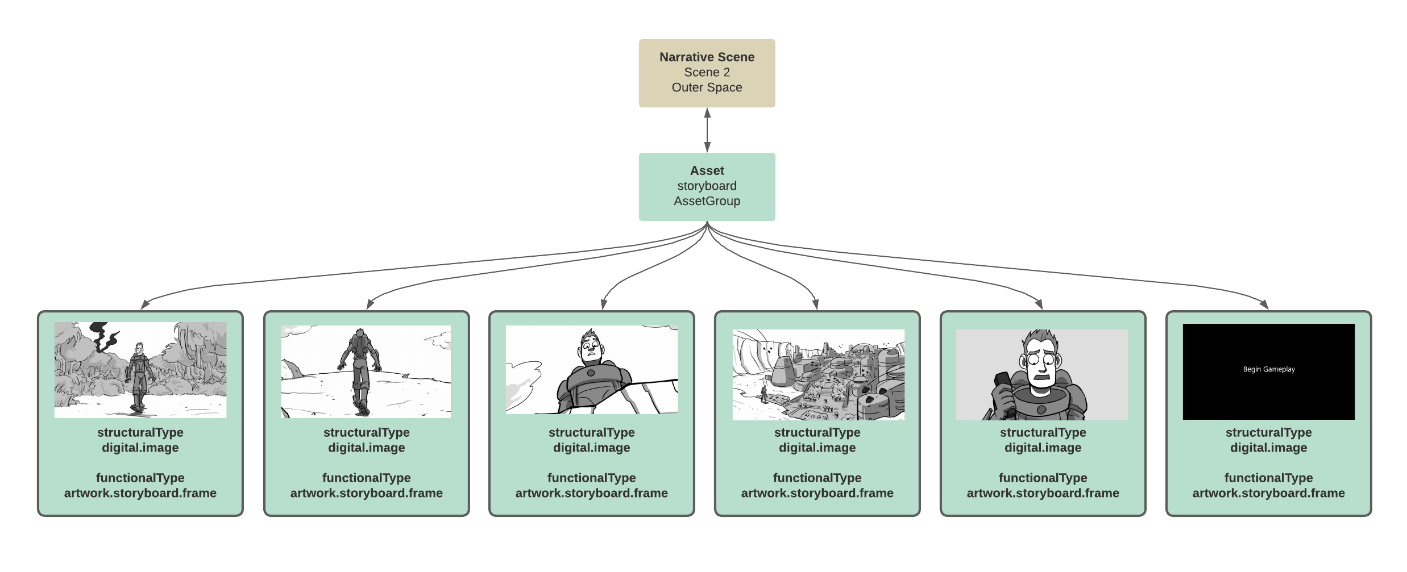
Movie and TV production is a visual medium, and the narrative elements eventually have to be turned into either physical or digital assets that are used in the production process. These don’t just appear out of nowhere – there is an iterative process that goes from narrative element to something that shows how it should be represented when it is turned into a production element. The ontology calls the result of this process Concept Art, which is a kind of asset that is a creative representation of something from the narrative. It exists for many elements of the production, and here we’ll show it for props and wardrobe.
Sometimes there are different ideas about how something should be represented – does Sven’s repair tool look like a socket wrench, a soldering iron, or a multimeter? – and it is up to the production team to decide which to use.
Concept Art: Images that illustrate ideas for potential depictions of elements of the creative intent.
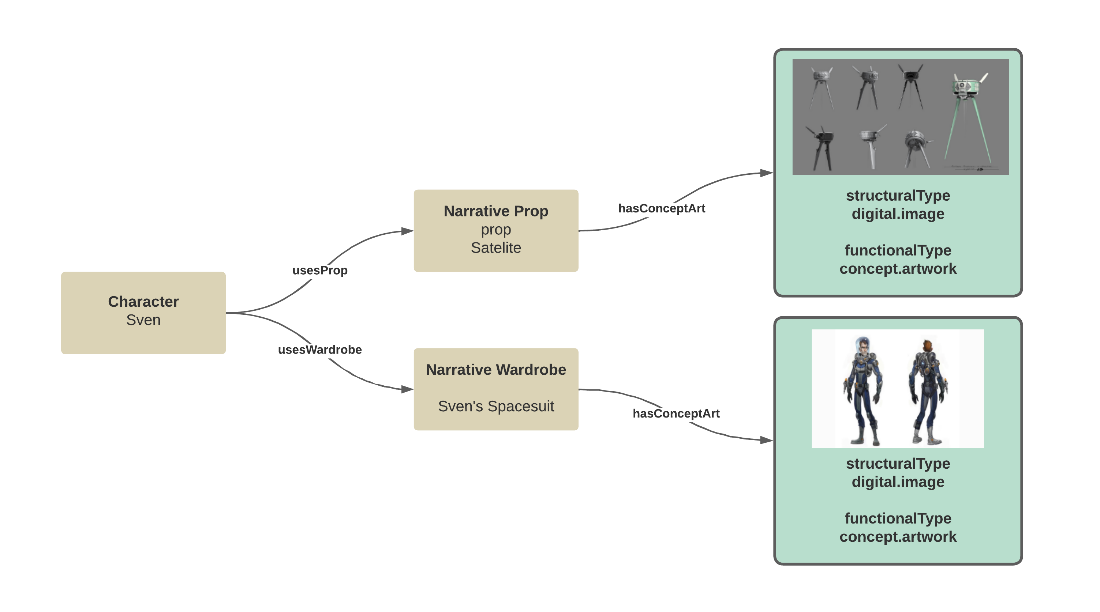
There is another sort of artwork not covered here – artwork or other material that is used to inspire during the production, such as images of hi- and low-tech tools to look at when thinking about the concept art for Sven’s repair tool. In the Ontology, these work much the same as concept art, and can be connected to individual narrative elements, to entire scenes, or even to the whole production. This kind of Asset is called Creative Reference Material.
Creative Reference Material: Images or other material used to inform the creation of a production element, to help convey a tone or look, etc.
Now we need Actors to portray the characters. Actors are a kind of Participant, as are Directors, Cinematographers, and so on. What’s special about Actors is that they need to be connected to the Characters. Some characters can be portrayed by more than one Actor (e.g., voice and motion capture, or actor and stunt double), and some Actors might portray more than one Character. We’ll add one for Kiera, who will be voice-only, and two for Sven – the main actor and a stunt double to use in a later scene.
Actors and Characters are connected together by a Portrayal, and the Portrayal is connected to a Production Scene. Portrayals are connected to lots of other pieces too (costumes, props, and so on.) but we won’t cover that here – some of it will be shown in the diagram in the next section though, and you can look at OMC: Part 7 Relationships to see the kinds of things that can be represented.
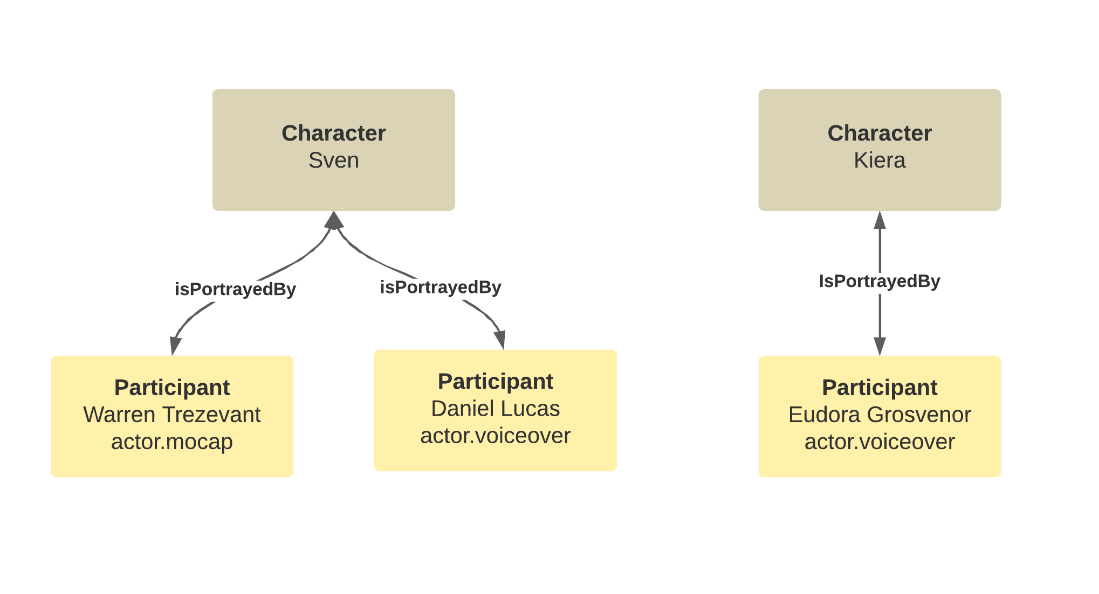
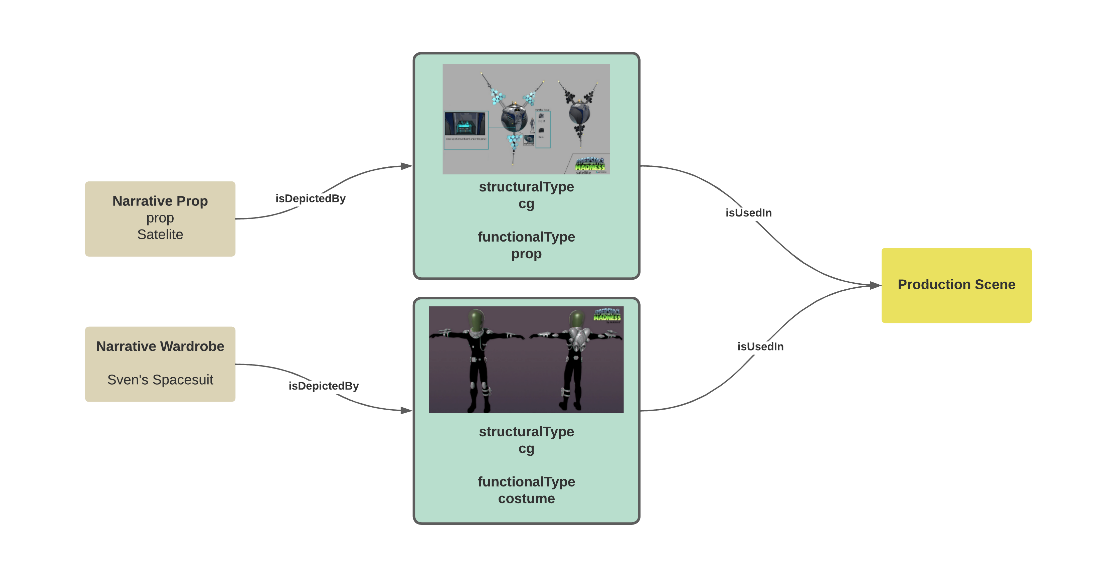
The next piece to think about is actually filming (or animating, in the case of an animated work) the narrative scenes. Looking at Narrative Scene 2, it has two very different parts: the first, in which Sven is happily repairing the satellite, and the second, where Sven flees the Trilobot and returns to his ship. These divisions are called production scenes and are created and used as required by artistic choices (different color management, different locations for filming) and technical requirements (requiring a green screen or equivalent vs filming as-is on a beach.) The HSM production team decided to break Narrative Scene 2 into two production scenes, dividing them just after Sven says “What the…?” It is possible to do this in other ways, of course, driven by creative or technical requirements. It is also possible for automated tools to make first suggestions about where to make these divisions, based on explicit notations in the script or inferred break points.
A Production Scene is going to be a central organizing element, you might think of it as a little bit like a call sheet. Lots of things are likely to be related to any given Production Scene, like the physical location, the crew and actors required, the date it is being filmed, all the props, wardrobe, infrastructure, etc. that will be needed as well as the Assets created during that filming of that scene.
The divisions into production scenes can be changed during filming, and so it is very important to be clear about what production scene is being used as the basis for a particular activity (filming, recording, rendering, etc.) See OMC: Part 2: Media Creation Context for lots and lots of details, most of which we will gloss over here.
The important thing for this overview is that a Production Scene has a Scene Descriptor that uniquely distinguishes it from all other production scenes past, present, and future. Production elements used in the Production Scene are tied though a chain of relationships back to the narrative elements. (That connection isn’t shown in this diagram, but the prop and costume in production scene 2a are the ones shown in the diagram above. In part 3 of the blog we’ll put all these pieces together into a complete graph.)
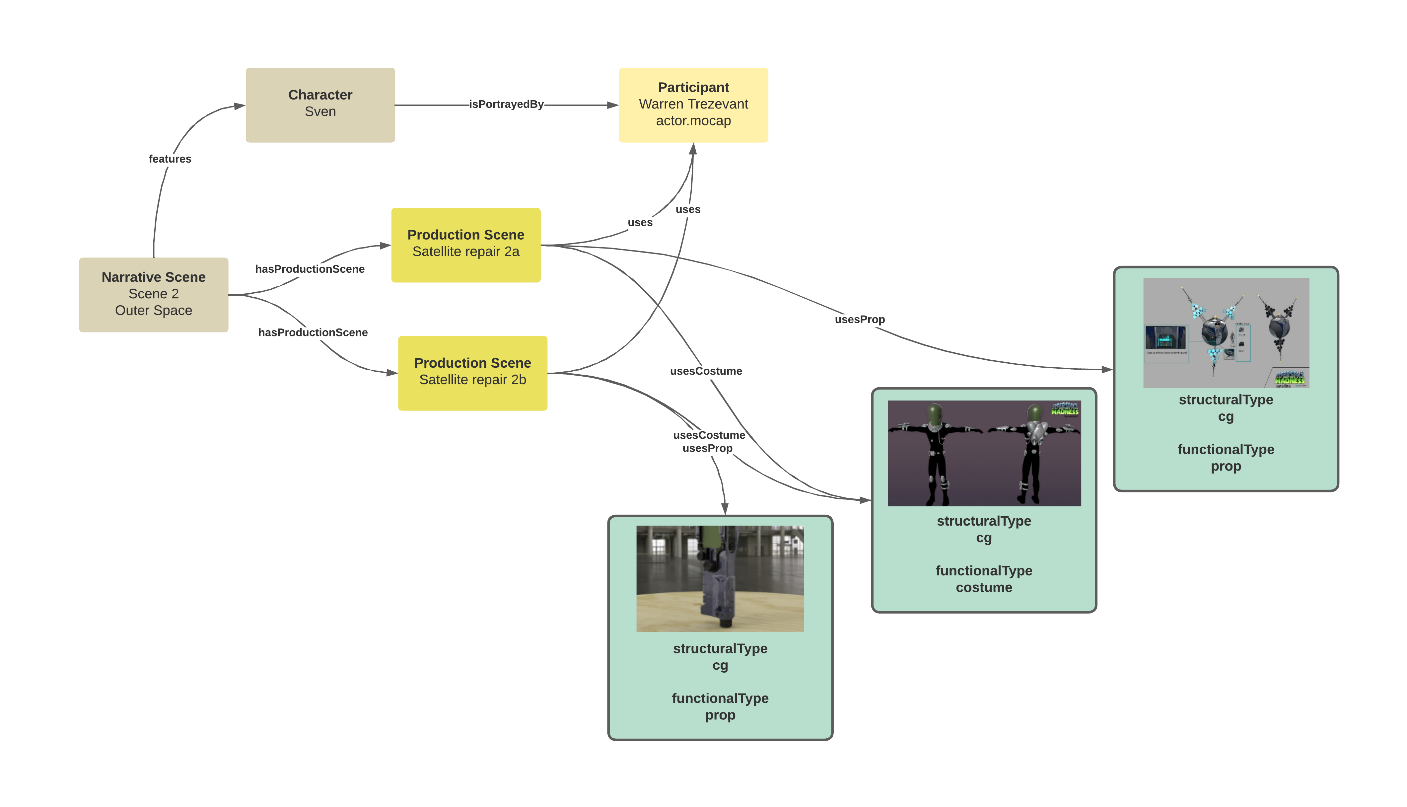
Conclusion to Part 2
This blog has shown how to use OMC to move from narrative elements to production elements. Once we have actors portraying characters and a set of real (or computer-rendered) props the production team can refine budgets and work on scheduling. It also means that if the script changes, those changes can propagate clearly and quickly to the people in the production team in charge of casting, call sheets, and prop fabrication.
In part 3, we’ll follow Sven and his communicator into filming and beyond.
If you found this blog series useful then let us know, and if you’re interested in additional blogs or how-to-guides let us know a specific use case and we can address it (email: info@movielabs.com). There’s also a wealth of useful information on the MovieLabs website at www.movielabs.com and the Ontology for Media Creation website.




